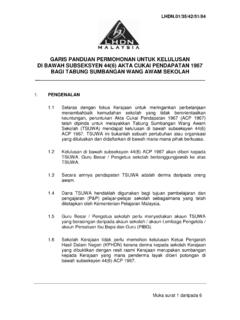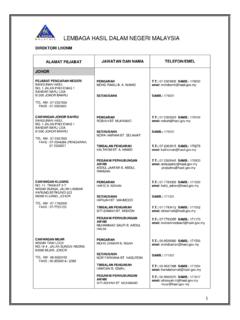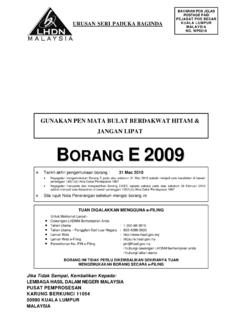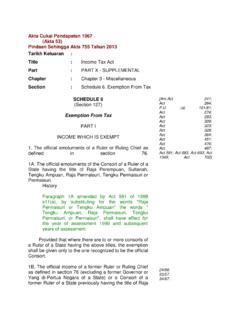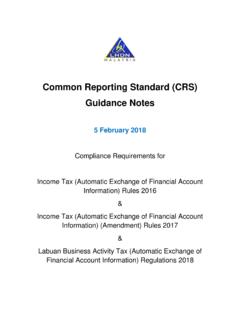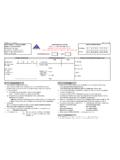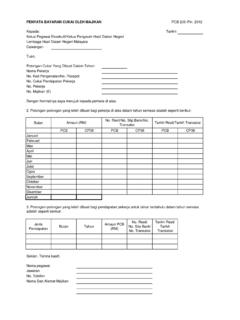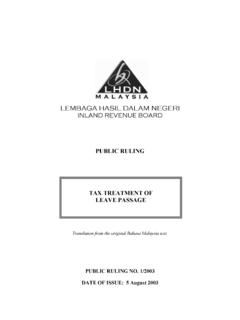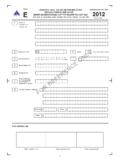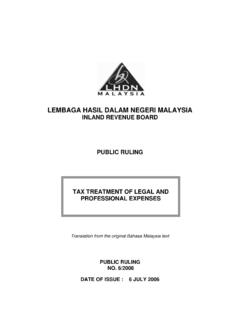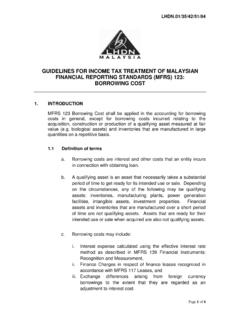Transcription of LHDN.01/35/(S)/42/51/84 GUIDELINES ON TAX ... - …
1 (S)/42/51/84 Page 1 of 12 GUIDELINES ON TAX treatment related TO THE IMPLEMENTATION OF MFRS 121 ( OR OTHER SIMILAR STANDARDS) 1. INTRODUCTION In a global economy, business entities in Malaysia may transact with other entities outside Malaysia or with their branches, subsidiaries or associated companies which operate outside Malaysia or vice versa. The transaction exposes the entity to the fluctuations in foreign currency exchange rates. In light of the circumstances, some business entities may have transactions in foreign currencies or may have foreign operations and hence non-Ringgit Malaysia (RM) currencies are used as their functional currency. Where a business entity uses non RM currency as its functional currency, the entity is required to translate its functional currency into RM currency for the purposes of financial reporting in Malaysia.
2 In this guideline foreign currency means a currency other than the functional currency of the entity; functional currency means the currency of the primary economic environment in which the entity operates; and presentation currency means the currency in which financial statements are presented. Page 2 of 12 2. PURPOSE This guideline is issued for the purpose of providing an explanation on the tax treatment related to the implementation of Malaysian Financial Reporting Standard 121 (MFRS 121) or any other accounting standards with regards to the impact of foreign currency translation. 3. TAX treatment In principle, gain or loss on foreign exchange which is revenue in nature is taxable or deductible when it is realised. Gain or loss on foreign exchange which is capital in nature, whether realised or unrealised is neither taxable nor deductible for income tax purposes.
3 However, when payment is made (realised), any gain or loss from the said payment will reduce or increase the amount of the qualifying expenditure entitled under the Income Tax Act 1967 (ITA) respectively. Example 1 Company A Bhd. purchased inventories from a Singaporean supply company in the amount of SGD20,000 on The exchange rate on transaction day was at On , Company A Bhd. paid SGD20,000 to the supplier. The exchange rate on is at The difference of RM2,000 (RM50,000-RM48,000) is a realised foreign exchange loss that can be allowed as a deduction under ITA. Page 3 of 12 [This scenario is under the assumption that Company A Bhd. is required to convert its RM currency to SGD currency in order to make the payment and only has RM currency account.] Summary of transactions from Example 1 Purchase Payment Date Cost SGD20,000 Rate = SGD1 = SGD1 Value at transaction date in RM RM48,000 RM50,000 Difference of payment in loss or gain on currency exchange (financial item) RM2,000 is a foreign exchange loss which is allowed as a deduction under ITA.
4 There are three different kinds of payment methods in business when entities adopt MFRS 121 in their transaction namely- (a) Business that uses RM currency unit as mode of transaction; (b) Business that uses neither RM currency unit nor functional currency unit as mode of transaction; and (c) Business that uses functional currency unit as mode of transaction. Business that uses RM currency unit as mode of transaction MFRS 121 requires an entity to translate foreign currency (RM currency or other currencies which is not functional currency) item into functional currency using the following procedures: Page 4 of 12 (a) On initial recognition, RM currency transaction is to be recorded in the functional currency by applying to the RM currency amount the spot exchange rate between the functional currency and the RM currency at the date of the transaction.
5 (b) Subsequently at the end of each financial year end- (i) RM currency monetary items (example: currency held as assets or liabilities which is to be paid or received in RM currency) shall be translated using the closing rate at the end of the reporting period. (ii) non-monetary items (example: prepaid rent, inventories, property, plant and equipment) that are measured in terms of historical cost in RM currency shall be translated using the exchange rate at the date of the transaction. (iii) non-monetary items that are measured at fair value in RM currency shall be translated using the exchange rate at the date when the fair value was determined. (c) At the end of a financial period, the financial position of a business shall be translated into RM currency as presentation currency using the following procedures: (i) assets and liabilities shall be translated at the closing rate at the date of that statement of financial position; and Page 5 of 12 (ii) income and expenses for each statement presenting profit or loss and other comprehensive income shall be translated at exchange rates at the dates of the transactions.
6 Foreign exchange differences are considered as realised when RM currency is physically converted into or exchanged for the functional currency. When RM denominated transaction is translated into functional currency and functional currency to RM presentation currency1, any difference will be treated as translation of gains or losses. The translation of gains or losses will neither be taxable as income nor deductible as tax deduction or incurred as qualifiying expenditure under ITA. For every purchase of asset denominated in RM, the actual cost of the asset is to be used as qualifying expenditure under ITA. For every purchase of inventories or sale transactions and any income and expenses denominated in RM, the actual cost will be used for tax purposes. Example 2 Company B Bhd.
7 , which is a subsidiary of a company from the United States adopted the USD as its functional currency and RM as its presentation currency. This company purchased a machine costing RM85,000 on and the payment is denominated in RM. The cost of the machine has been fully 1 The exchange rates at the time of the transactions and at the time of reporting or settlement of the transactions may be different. As a result, foreign exchange differences are charged to profit and loss account and tax adjustment is required. Page 6 of 12 settled on the same day and translated into USD as functional currency. The exchange rate on the settlement date is at , therefore the translated cost of the machine is USD25,000.
8 At the end of the company s financial period on , the cost of the machine in USD functional currency will be translated into RM as presentation currency. The exchange rate on that date is Although there is a translation loss of RM5,000 on foreign exchange (RM90,000-RM85,000), this amount is a non qualifying expenditure under ITA as it is merely a translation loss of the transaction. Therefore, the qualifying expenditure for the machine is only RM85,000. [Company B Bhd. used its RM denominated bank account to make the payment.] Summary of transactions from Example 2 Purchase / payment Translation into presentation currency Date Cost RM85,000 Rate = USD1 USD1 = USD Cost USD25,000 Exchange amount RM90,000 Difference Translation loss of RM5,000 will not be qualified as qualifying expenditure under ITA.
9 Page 7 of 12 Example 3 Company B Bhd. also purchased raw material costing RM34,000 on and the payment is denominated in RM. The cost of the raw material has been fully settled on the same day and translated into USD functional currency. The exchange rate on the settlement date is at Therefore, the raw material translated cost is USD10,000. At the end of the company s financial period on , the cost of the raw material will be translated into RM as presentation currency. The exchange rate on that date is at Although there was a translation loss of RM2,000 (RM36,000-RM34,000) on foreign exchange, this amount is not allowed as an expense under ITA as it is merely a translation loss. Therefore, the allowable expense for the raw material will be RM34,000.
10 [Company B Bhd. used its RM denominated bank account to make the payment.] Summary of transactions from Example 3 Purchase / payment Translation into presentation currency Date 30/6/2014 31/12/2014 Cost RM34,000 Rate = USD1 USD1 = USD cost USD10,000 Exchange amount RM36,000 Difference Translation loss of RM2,000 will not be allowed as a deduction under ITA. Page 8 of 12 Business that uses neither RM currency unit nor functional currency unit as mode of transaction Notwithstanding the requirement under MFRS 121 for using foreign currencies, any entity is required to record the spot exchange rate between the non-RM currency and the RM currency at the date of the transaction in order to determine the RM exchange value for tax purposes. Foreign exchange differences are considered as realised when the RM currency is physically converted into or exchanged for the other foreign currencies or functional currencies.
